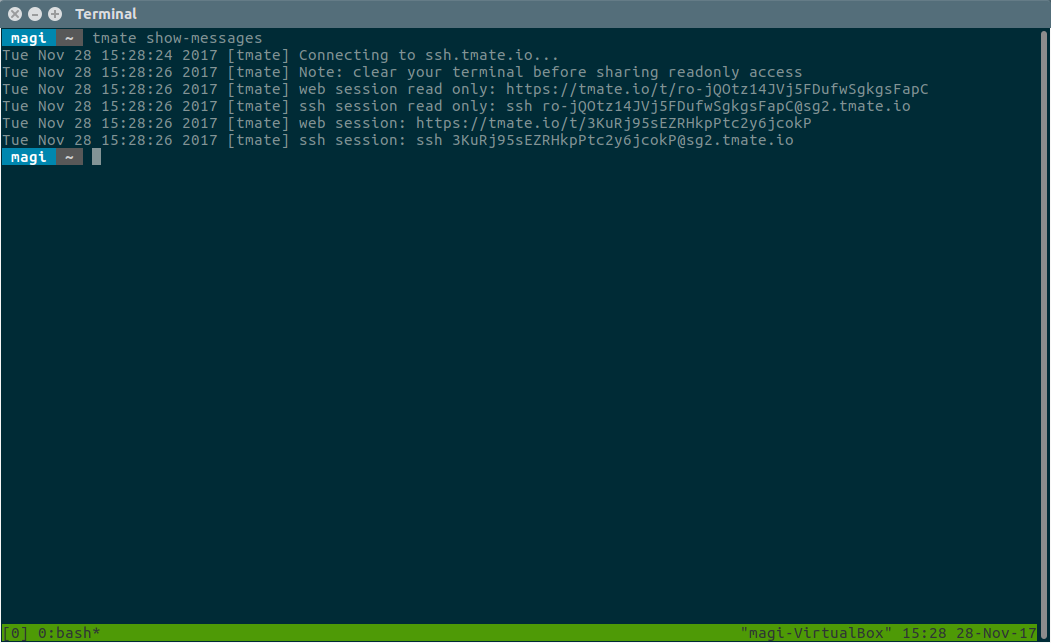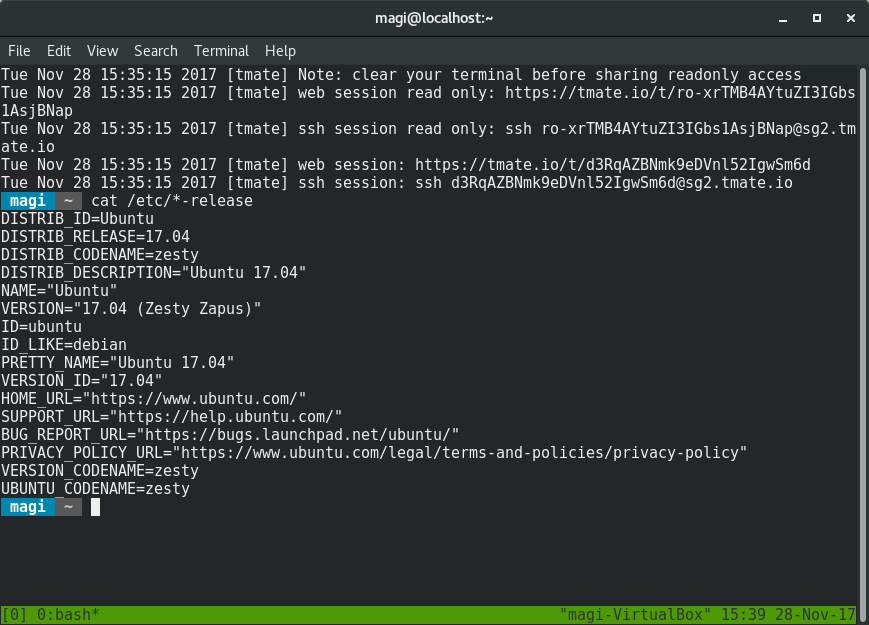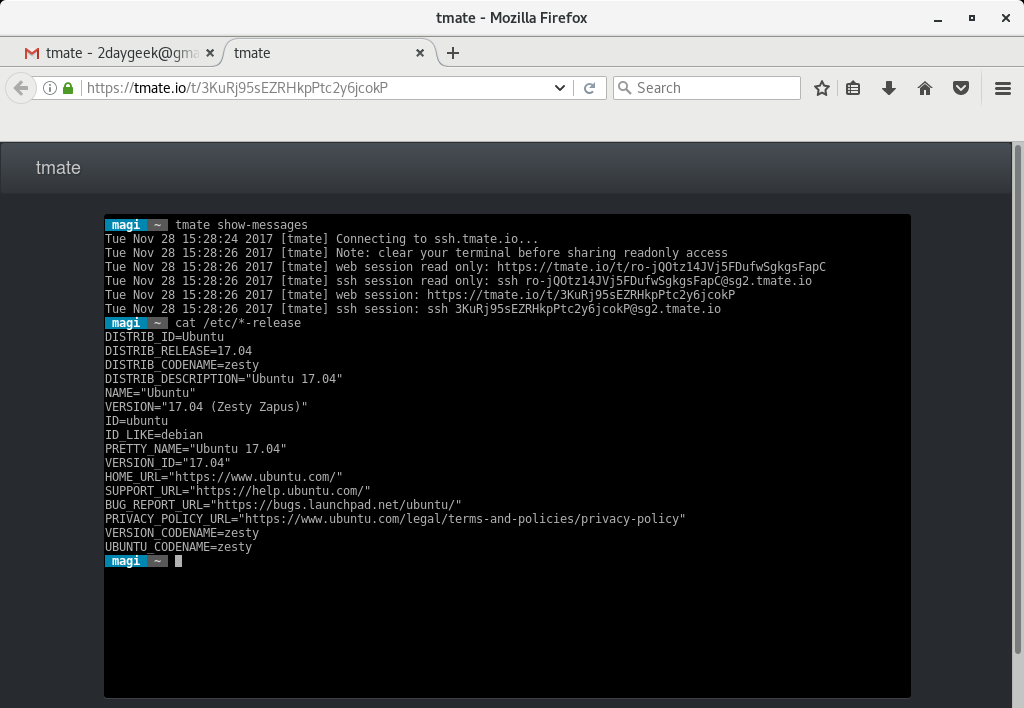Quick terminal session sharing tool:tmate
tmate means teammates, which is a fork of tmux and uses the same configuration information (such as shortcut key configuration, color scheme, etc.). It is a terminal multiplexer with the ability to share terminals on the fly. It allows the creation and manipulation of multiple terminals from a single screen, which can also be shared with other colleagues.
You can detach the session, let the job run in the background, and then reconnect to the session when you want to view the status. tmate provides an instant pairing solution that allows you to share a terminal with one or more teammates.
There is a status bar on the screen, which displays some shared information of the current session such as ssh commands.
When running tmate, an ssh connection to tmate.io (the backend server maintained by the tmate developer) will be created in the background through libssh.
The tmate.io server's ssh keys are verified via a DH exchange.
Clients authenticate via local ssh keys.
After the connection is created, the local tmux server generates a 150-bit (unguessable random characters) session token.
Teammates can connect to tmate.io via a user-supplied SSH session ID.
Since the tmate.io server requires a local ssh key to authenticate the client, one of the prerequisites is to generate an SSH key. Remember, each system needs its own SSH key.
$ ssh-keygen -t rsa Generating public/private rsa key pair. Enter file in which to save the key (/home/magi/.ssh/id_rsa): Enter passphrase (empty for no passphrase): Enter same passphrase again: Your identification has been saved in /home/magi/.ssh/id_rsa. Your public key has been saved in /home/magi/.ssh/id_rsa.pub. The key fingerprint is: SHA256:3ima5FuwKbWyyyNrlR/DeBucoyRfdOtlUmb5D214NC8 magi@magi-VirtualBox The key's randomart image is: +---[RSA 2048]----+ | | | | | . | | . . = o | | *ooS= . + o | | . =.@*o.o.+ E .| | =o==B++o = . | | o.+*o+.. . | | ..o+o=. | +----[SHA256]-----+
tmate is already included in the official repositories of some distributions and can be installed through the package manager.
For Debian/Ubuntu, you can use the APT-GET command or the APT command to install.
$ sudo apt-get install software-properties-common $ sudo add-apt-repository ppa:tmate.io/archive $ sudo apt-get update $ sudo apt-get install tmate
You can also install tmate from the official repository.
$ sudo apt-get install tmate
For Fedora, use the DNF command to install.
$ sudo dnf install tmate
For systems based on Arch Linux, use the Yaourt command or the Packer command to install from the AUR repository.
$ yaourt -S tmate
or
$ packer -S tmate
For openSUSE, use the Zypper command to install.
$ sudo zypper in tmate
After successful installation, open a terminal and enter the following command. A new session will open. At the bottom of the screen, you can see the SSH session ID.
$ tmate <img src="/static/imghw/default1.png" data-src="https://img.php.cn/upload/article/000/465/014/170839825763674.png" class="lazy" alt="Quick terminal session sharing tool:tmate">
It should be noted that the SSH session ID will disappear after a few seconds, but it does not matter, you can obtain these details through the following command.
$ tmate show-messages
The show-messages command of tmate will display the log information of tmate, which contains the content of the ssh connection.

Now, share your SSH session ID with your friends or colleagues to allow them to view the terminal session. In addition to the SSH session ID, you can also share the web URL.
In addition, you can also choose whether to share a read-only session or a read-write session.
Just run the SSH terminal ID you got from your friend on the terminal. Something like this.
$ ssh session: ssh [email protected]

Just open the browser and visit the URL your friend gave you. Like below.

Just enter exit to exit the session.
[Source System Output] [exited] [Remote System Output] [server exited] Connection to sg2.tmate.io closed by remote host。 Connection to sg2.tmate.io closed。
The above is the detailed content of Quick terminal session sharing tool:tmate. For more information, please follow other related articles on the PHP Chinese website!

Hot AI Tools

Undresser.AI Undress
AI-powered app for creating realistic nude photos

AI Clothes Remover
Online AI tool for removing clothes from photos.

Undress AI Tool
Undress images for free

Clothoff.io
AI clothes remover

Video Face Swap
Swap faces in any video effortlessly with our completely free AI face swap tool!

Hot Article

Hot Tools

Notepad++7.3.1
Easy-to-use and free code editor

SublimeText3 Chinese version
Chinese version, very easy to use

Zend Studio 13.0.1
Powerful PHP integrated development environment

Dreamweaver CS6
Visual web development tools

SublimeText3 Mac version
God-level code editing software (SublimeText3)

Hot Topics
 What computer configuration is required for vscode
Apr 15, 2025 pm 09:48 PM
What computer configuration is required for vscode
Apr 15, 2025 pm 09:48 PM
VS Code system requirements: Operating system: Windows 10 and above, macOS 10.12 and above, Linux distribution processor: minimum 1.6 GHz, recommended 2.0 GHz and above memory: minimum 512 MB, recommended 4 GB and above storage space: minimum 250 MB, recommended 1 GB and above other requirements: stable network connection, Xorg/Wayland (Linux)
 Linux Architecture: Unveiling the 5 Basic Components
Apr 20, 2025 am 12:04 AM
Linux Architecture: Unveiling the 5 Basic Components
Apr 20, 2025 am 12:04 AM
The five basic components of the Linux system are: 1. Kernel, 2. System library, 3. System utilities, 4. Graphical user interface, 5. Applications. The kernel manages hardware resources, the system library provides precompiled functions, system utilities are used for system management, the GUI provides visual interaction, and applications use these components to implement functions.
 vscode terminal usage tutorial
Apr 15, 2025 pm 10:09 PM
vscode terminal usage tutorial
Apr 15, 2025 pm 10:09 PM
vscode built-in terminal is a development tool that allows running commands and scripts within the editor to simplify the development process. How to use vscode terminal: Open the terminal with the shortcut key (Ctrl/Cmd). Enter a command or run the script. Use hotkeys (such as Ctrl L to clear the terminal). Change the working directory (such as the cd command). Advanced features include debug mode, automatic code snippet completion, and interactive command history.
 How to check the warehouse address of git
Apr 17, 2025 pm 01:54 PM
How to check the warehouse address of git
Apr 17, 2025 pm 01:54 PM
To view the Git repository address, perform the following steps: 1. Open the command line and navigate to the repository directory; 2. Run the "git remote -v" command; 3. View the repository name in the output and its corresponding address.
 Where to write code in vscode
Apr 15, 2025 pm 09:54 PM
Where to write code in vscode
Apr 15, 2025 pm 09:54 PM
Writing code in Visual Studio Code (VSCode) is simple and easy to use. Just install VSCode, create a project, select a language, create a file, write code, save and run it. The advantages of VSCode include cross-platform, free and open source, powerful features, rich extensions, and lightweight and fast.
 How to run java code in notepad
Apr 16, 2025 pm 07:39 PM
How to run java code in notepad
Apr 16, 2025 pm 07:39 PM
Although Notepad cannot run Java code directly, it can be achieved by using other tools: using the command line compiler (javac) to generate a bytecode file (filename.class). Use the Java interpreter (java) to interpret bytecode, execute the code, and output the result.
 What is the main purpose of Linux?
Apr 16, 2025 am 12:19 AM
What is the main purpose of Linux?
Apr 16, 2025 am 12:19 AM
The main uses of Linux include: 1. Server operating system, 2. Embedded system, 3. Desktop operating system, 4. Development and testing environment. Linux excels in these areas, providing stability, security and efficient development tools.
 How to run sublime after writing the code
Apr 16, 2025 am 08:51 AM
How to run sublime after writing the code
Apr 16, 2025 am 08:51 AM
There are six ways to run code in Sublime: through hotkeys, menus, build systems, command lines, set default build systems, and custom build commands, and run individual files/projects by right-clicking on projects/files. The build system availability depends on the installation of Sublime Text.






